In 2018 we were actively participating in different conferences: both as speakers and sponsors. By the end of the year we had a large list of conferences that's why we decided to write about all the trips we had. The article tells about advantages and disadvantages of conferences, and gives advice to all the newbies that will help them to avoid mistakes and spend conference time productively.
Guys! Conference Time!
Come on grab your friends
We'll go to very distant lands
With PVS-Studio team and a unicorn
The fun will never end, Conference Time!
No, we aren't stoned - it's just an introduction to this article, where we are going to tell you about our first experience of intense participation in exhibitions and conferences of 2018.
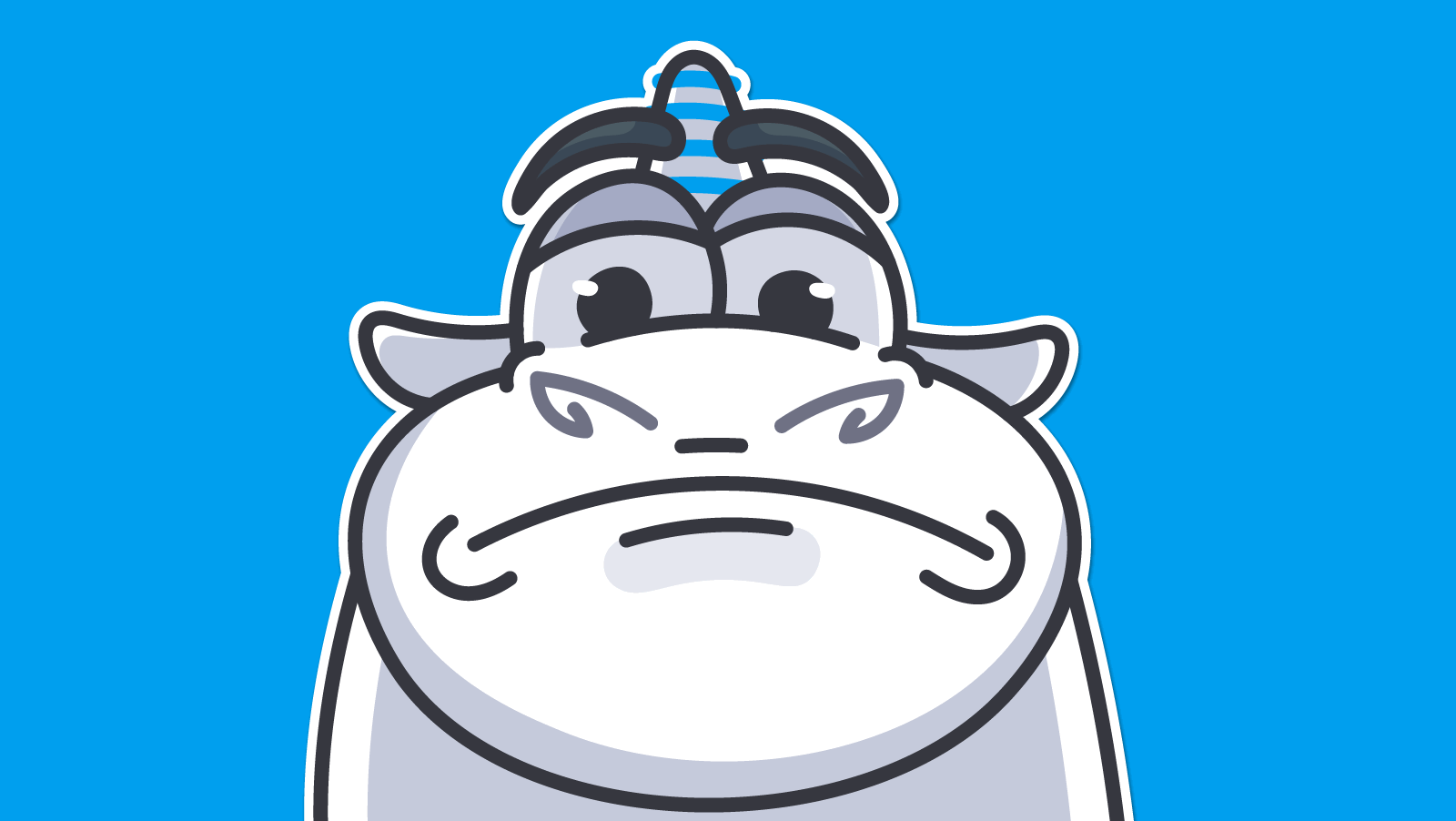
That's what my face looked like when my coworker Andrey Karpov showed me a list of events to be held in 2018 and asked me which of them I would like to take part in.
From mid-April to mid-December, we've been regularly participating in IT conferences and expos in a number of cities and countries. Overall, we participated in 23 events, which is our current personal record. At some events, we gave talks or held meetups and workshops; at others, we showed up with our exhibition booth or attended talks ourselves; at some others, we did all of that. Of course, we had done it before, but it had never been that intense. For the most part, our developers would come with a presentation twice a year, but we hadn't brought a booth to entice attendees before.
In order to have a more visual and convenient way of keeping the list of upcoming trips, Andrey had a big wall calendar pinned in our office so that he could write in the event titles and dates. As you can see, all those marks don't make much sense, but there are lots of them, which means we were going to have an enormous amount of work to do.
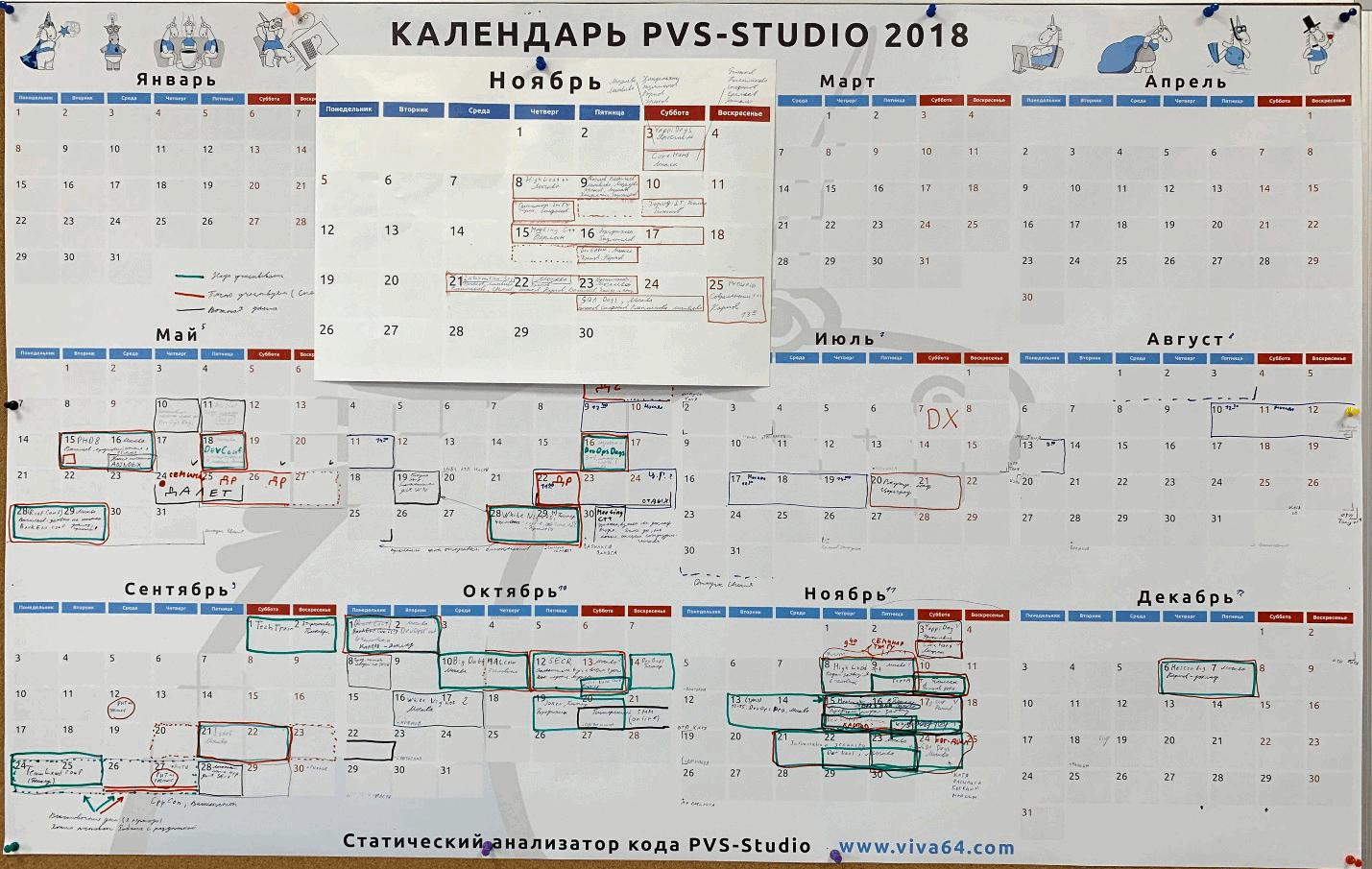
Before I start listing the events we took part in, I'd like to share a few tips and examples from our own experience with those who are only planning to go to their first exhibition or conference. I should warn you right off that my recommendations will mostly apply to product-making companies who see events as, among other things, means to tackle sales and marketing issues, rather than companies who come for hunting. If you are an experienced booth staffer or if you are interested only in presentations and don't feel like reading what looks to you as Captain Obvious style observations, feel free to skip to the "Events that we attended" section.
It's obvious that both the booth and its contents should have some striking trait to catch a visitor's eye and make them come up to you and start a conversation. But it's easier said than done. Your booth is in fact your business card but of a greater size. The more creative and informative your business card is in comparison with others', the more chances that it will help you gather leads.
The company name, logo, and specialization should be legible and large enough for people to read them without straining their eyes. And please do not use vague wording like "Keeping Up with the Times" or "Stick with Us, We're Cool" even if that is your company's motto. Nobody buys into lines like that; they are just a dull spot like many others in the flood of information.
Use key words that reflect the event topic and you are sure to engage the audience. For instance, at a conference for DevOps developers, it would be a good idea to list the popular platforms that your product can integrate with; at an event for team leaders, mention something that provides control over the development process quality and helps save the budget; at programmer conferences, include code examples that are sure to strike the eye of 90% of programmers.
If you have large companies among your clients and you are allowed to use their logos in your ads, don't hesitate to include them in your graphics: it will help you attract prospects. Even if they haven't seen or heard about you before, they are more likely to stop by if they see a familiar logo, which also means they will be more interested and willing to talk.
The key elements of the text should be placed high enough above the floor - typically 1.5 meters and higher. Thus you can make sure you won't screen the text from visitors and they will see everything you want them to see.
Now you may be thinking that while I initially advised against using too much printed text, putting together all I said after that implies having a huge block of letters and pictures. Well, what I mean by a booth is a structure consisting of several elements: a Press-Wall or Pop-Up backwall, a counter or table, a Roll-Up, and a TV monitor for visuals and interactive activities. How exactly to arrange the graphics on these elements is up to you to decide.

From left to right: white Roll-Up, blue Pop-Up, Pop-Up case/counter, and monitor (thanks Captain Obvious)
From the very beginning, we discarded the idea of putting up elaborate structures and modern stylish booths, which you typically see at exhibitions. We had our reasons for that:
It was a wise decision because the booth is an important yet not central element of your event activity.
We have learned that no matter how gorgeous the booth might look, you'll end up with wasted time and money if you have assigned the wrong staff or haven't taken care of the giveaways or interactive part.
Whether you should give a presentation or just bring a booth is solely your choice, but we find it best to do both. There are different types of attendees: some only attend presentations, while others come to take a look at the sponsors and make new contacts. That's why you want to use different ways of interacting with the guests to have full coverage.
Event management will typically provide the visitors with a directory with the schedule of presentations. But with all that fuss and buzz around, people may easily miss your talk and go listen to someone else. So, make sure to bring a bunch of leaflets to leave on the tables in the lunch area or, if possible, pin to the info boards, and, of course, hand out to the guests at your booth.
As for promotional items, or giveaways, you're free to go as far as your imagination can take you, but we personally stick to the principle that the best giveaway item is something relatively compact, light, and not too costly to produce.
For instance, post-it notes are a must-have at any event. 99% of the visitors eagerly grab them. As for the rest of your items, you'll have to test and refine them depending on the type of event and audience, and bring them again next time.
For example, we have found that, among keychains, magnets, post-it notes, and so on, our desktop spiral-bound statuses for programmers work extremely well. They are light and compact and convey all the joy and pain of being a developer. After that, we made similar statuses for team leaders and testers.
When offering contests or challenges to solve, we reward participants with items that are more significant and expensive. Now, there is always this type of visitors at any event who come solely for freebies. They don't really care what you give them provided that it's free. They don't care what you have to tell them. "Just gimme loot and get lost", is what they are thinking. They don't even know if they need it at all yet. It's sad, but there's nothing you can do about them. If you are lucky to spot such people right off, simply give them whatever items you have the most of and keep the rest as gifts for participating in activities.
Activities are a crucial part of your marketing strategy. Without them, you can attract visitors only in the beginning, before the speakers start out with their presentations and guests simply roam around to kill time and grab a few giveaways. If you are not a well-known company and you have only brochures or flyers to hand out, people won't linger at your booth for long. Besides, attendees don't like reading brochures with "too many letters". You have to come up with new ways to engage the guests all the time. One way is to offer activities that would be interesting to your target audience such as solving challenges printed on hand-out sheets or accessed on social media or your website, or video games played on a laptop connected to the monitor. The person who solved the challenge or beat the game should get a prize - the more difficult the task, the more valuable the prize. The spirit of competition is always there, you know. You could also use this activity as an opportunity to strike up a conversation, explain the right solution, or show how it connects to your company.
In 2018, for instance, we would bring leaflets with code snippets from well-known projects that we had already checked with our analyzer PVS-Studio. The guests were encouraged to find a fairly trivial yet interesting bug in that code and explain it. Whether or not they succeeded didn't matter that much to us as the activity itself would make them interested anyway. Alone or together with colleagues, they read the code trying to find the bug and then came back to show their solution. We, in return, would explain line by line how our analyzer had detected it rather than simply say if their solution was right or wrong. At the end, no matter if they won or not, we would reward them with our desktop statuses. That strategy helped us achieve the following:
These 5 steps help the booth staff to make a good impression and attract prospects to themselves and the product, thus paving the way for post-show follow-up.
Many times we've seen companies - both large and small, well-known and little heard of - assign the wrong booth staffers. He or she would just sit there staring into the screen of their smartphone or laptop, all by themselves, and you could tell how bored they were. Another type is an introvert developer who can answer specific technical questions but is unable to engage the audience.
Whomever you pick for this work should look clean and neat. In order to make them stand out of the motley crew of attendees and exhibitors, get each of your staffer a T-shirt or hoodie of your colors and with your logo printed on it. The staff will have to work hard, but they shouldn't go overboard either. Obtrusiveness is even worse than indifference - it may put people off even more. Ideally, here's how we do it:
The girls smile at and greet guests who have noticed our booth and are already on their way towards it, and engage them in a conversation. They tell the guests about static analysis and PVS-Studio, hand out the giveaways for solving a challenge or just as a gift. This helps get the guest willing to learn some technicalities about our product - and that's where our developers come in. No doubt, our guys are cool and could manage it all themselves, without the girls' support, but somehow we have ended up with this high-performing combination of two teams. After all, most programmers are male and they are seeing fellow programmers all the time, both at work and shows, so adding in a few females interested in their work helps brighten things up. Just don't pick staffers only for their good looks; choose those who know and could explain the general stuff to prospects without assistance from the developers.
If an event runs for several days, networking is best to do at the end of the first day, at a beer party and when board games and interactive games come in. Informal setting is perfect for meeting new people, making new business contacts, and discovering valuable insights.
Sometimes event organizers will hold meetings for sponsors and some of the participants the day before the event. This is where you can talk to other exhibitors and learn more about the companies that you will be competing with for audience attention soon.
Networking is definitely a useful part. If you want to learn more, there are tons of articles that elaborate on this topic. So, make sure to get in the right mood, stay positive, don't forget to bring your business cards, and try to enjoy the process.
In addition to a brief overview, for each event that we gave a talk at, I will attach the video and the presentation plus a download link where possible. Since it takes a while before the organizers upload the videos, this list will be updated. I hope I'll finish it in the next few months. OK, here we go:
For over 20 years Basta! is the leading and independent conference for Microsoft-Technologies and JavaScript. BASTA! enables developers and software-engineers, with competent offers about C#, .NET-Framework and web technologies, to keep up with recent developments.
For us, it was the first conference outside Russia and Belarus. Our team was represented by CEO Evgeny Ryzhkov, and it was his debut as a participant, speaker, and sponsor.
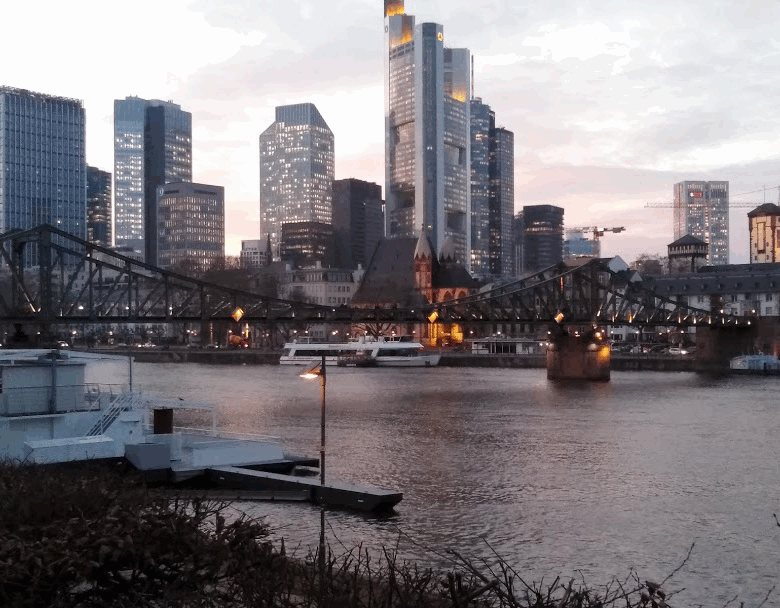
Frankfurt
Here's Evgeny's comment on that experience:
I had a very positive impression of Frankfurt, of course, but the event itself impressed me even more. It was the first conference for developers where I asked, "What do you know about PVS-Studio?", and people would answer, "PVS-Studio? What's that?" It's awesome! It means new audience, new market, new customers, who don't know about our product yet. Frankly, though, I find it a bit surprising because Germany is the second after the USA in terms of PVS-Studio copies sold. It's a rough estimate, but I think it's pretty close to reality.
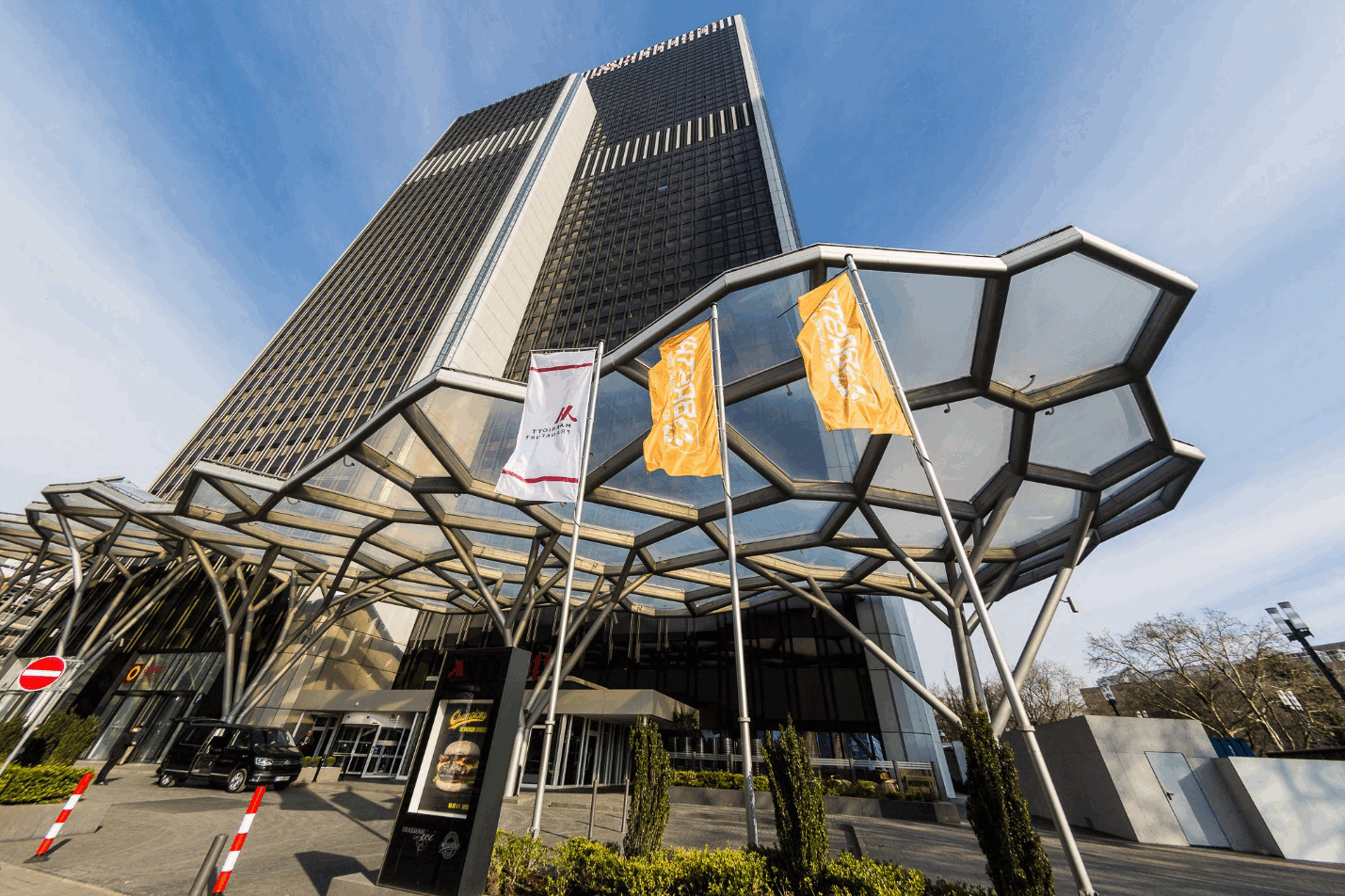
Frankfurt Marriott Hotel, Basta! venue
We participated both as sponsors and speakers. More exactly, we asked one of our clients in Germany, EPLAN Software, to give a presentation on static code analysis. Among other topics, the speaker, Roman, was talking about their company's experience of using PVS-Studio. Since the presentation was in German, I didn't understand a word.
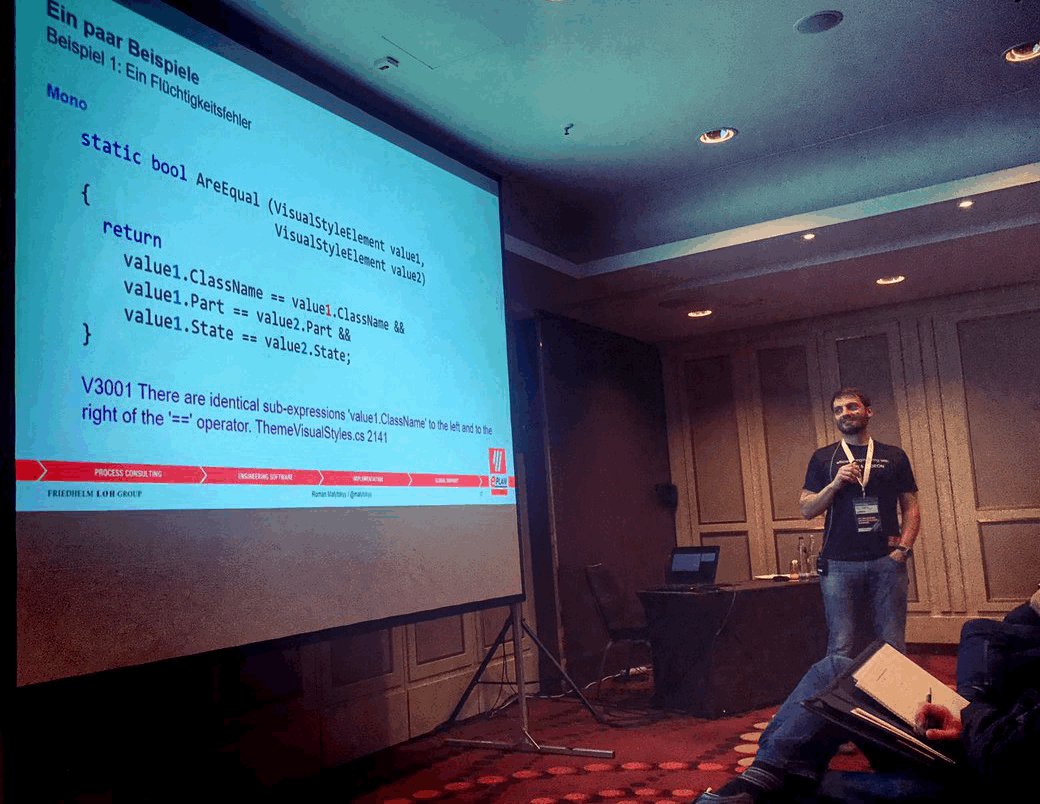
To be honest, I totally screwed up as a booth staffer. No giveaways, no language skills, no teammates around, who were much more adept at this job, as I learned later in Russia, to help me out. But since Basta! means new prospects, I'm sure we'll come again, well-prepared and fully equipped!
CoreHard is a conference that unites not only C++ engineers, but also those who are interested in low-level development in C and Assembler, programming of controllers, Internet of Things, highload server solutions and in any kind of "hardcore" development.
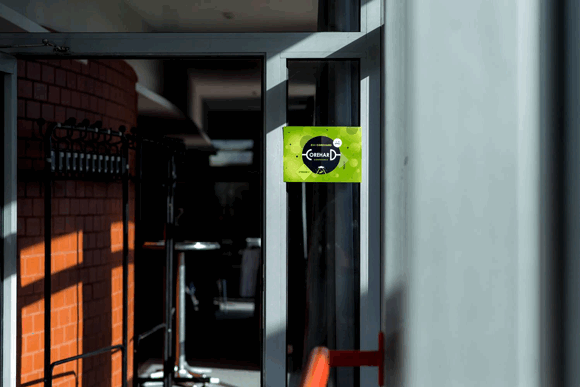
This conference was the true opening of 2018's event season for us. We've been coming to Minsk as sponsors for three years now and find it even better each time in terms of both the management aspect and the quality of presentations.
It was the first time we came as a large delegation of eight persons with a booth and the talk "Data Flow Analysis in a Static Code Analyzer" amazingly presented by Pavel Belikov.
It was there that we tested our desktop statuses with the unicorn logo for programmers and other giveaway items and found that they worked well; explored the right and wrong ways of attracting developers, figured out how to make those who show interest in your product even more interested, and how to engage introverts in a conversation.
Andrey also visited Wargaming's office to see the developer team who were using PVS-Studio in their work. He answered a bunch of questions, promised to make some improvements to the analyzer, and so on. He also had his photo taken near the tank replica in the hall because, you know, you can't just leave their office without doing that.
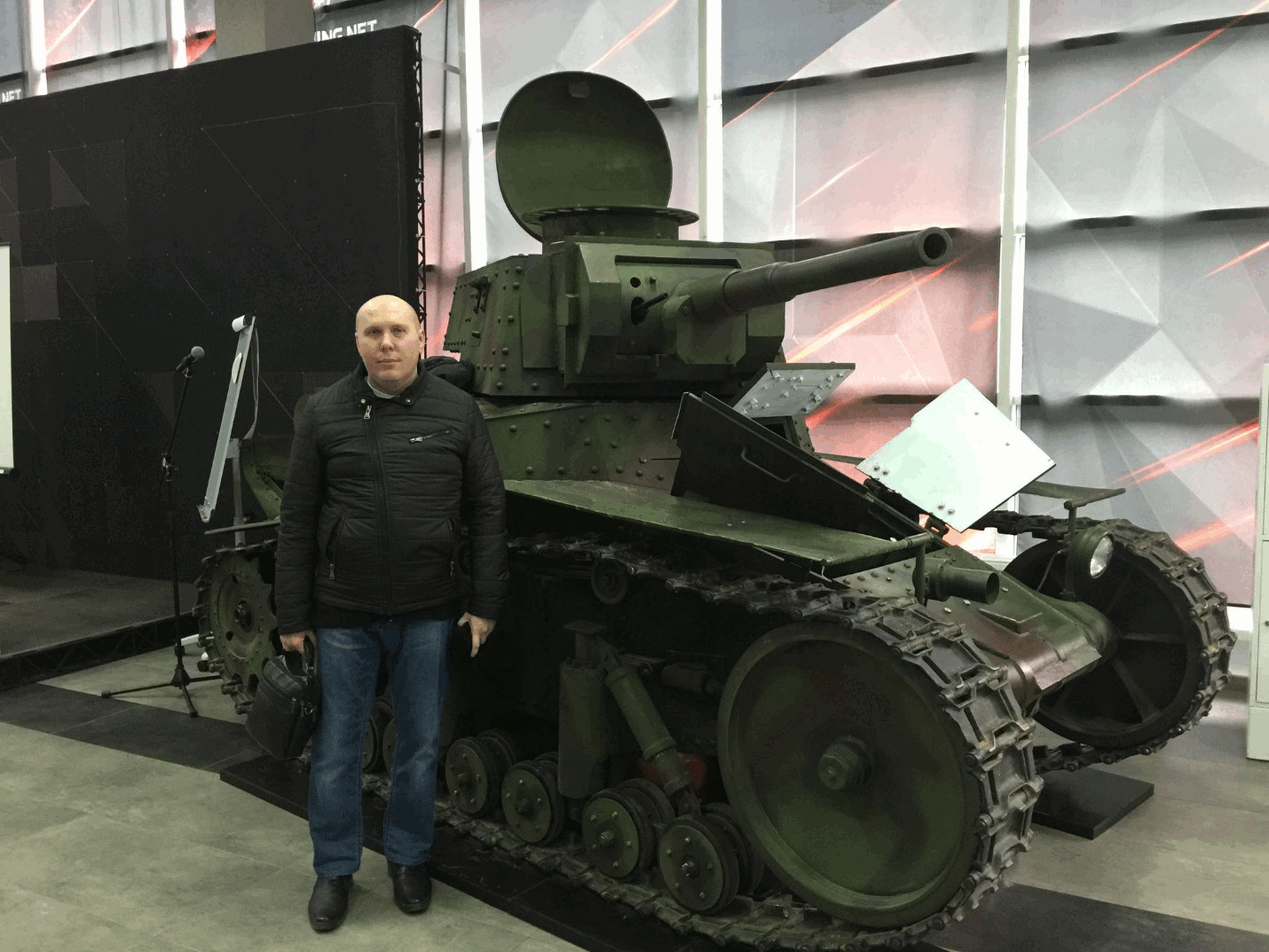
Andrey and tank replica
To save space, I refer you to our VK post for a complete story about our CoreHard experience. After all, I still have 21 events to tell you about o_O.
We visited CoreHard once again in the fall, with a new talk by Evgeny Ryzhkov, "Information Security and Software Development". It was okay, but we also learned one obvious thing: you should bring new giveaways each time you visit the same event. We were hoping that 70-80% of the attendees would be first-timers and our merchandise would work just as well. But it turned out that most of the visitors already had our items and were looking for something new.
Talk presentations can be downloaded from the conference's official Telegram channel.
C++ Russia brings together hundreds of professional C++ developers, and we participate every year. It's where we feel at home, and we simply couldn't miss it. C++ was the first language we supported in PVS-Studio and made thousands of diagnostics for, which we tested on hundreds of projects.
Even though we see a number of familiar faces each time at this conference, we still try to communicate the idea of how important static analysis is for improving code quality. The conference is constantly evolving, with more and more C++ gurus and stars being invited as speakers: Jon Kalb, Daveed Vandevoorde, Andrei Alexandrescu, Herb Sutter, and others.
The event was held at Park Inn Pribaltiyskaya, which was very convenient since we were also staying there and didn't have to carry the pile of giveaways around the city. We just had to walk a few stories down to reach our booth. Based on our previous experience at CoreHard and the giveaways brought/given ratio, we estimated what looked like a sufficient amount to cover 80% of the attendees at C++ Russia. Boy, how wrong we were... We ran out of our stuff long before the end of the first day despite our trying to give it only as prizes for participating in activities. The conclusion is, bring more items than you expect to give away. It's better to take the excess back home or just hand it out to attendees and exhibitors than have nothing to offer on the next day (it still depends on the event's topics, though). At this conference, we gave two talks at once: one by CTO Andrey Karpov, who had a full house with people standing, and the other by our leading developer Sergey Vasilyev.
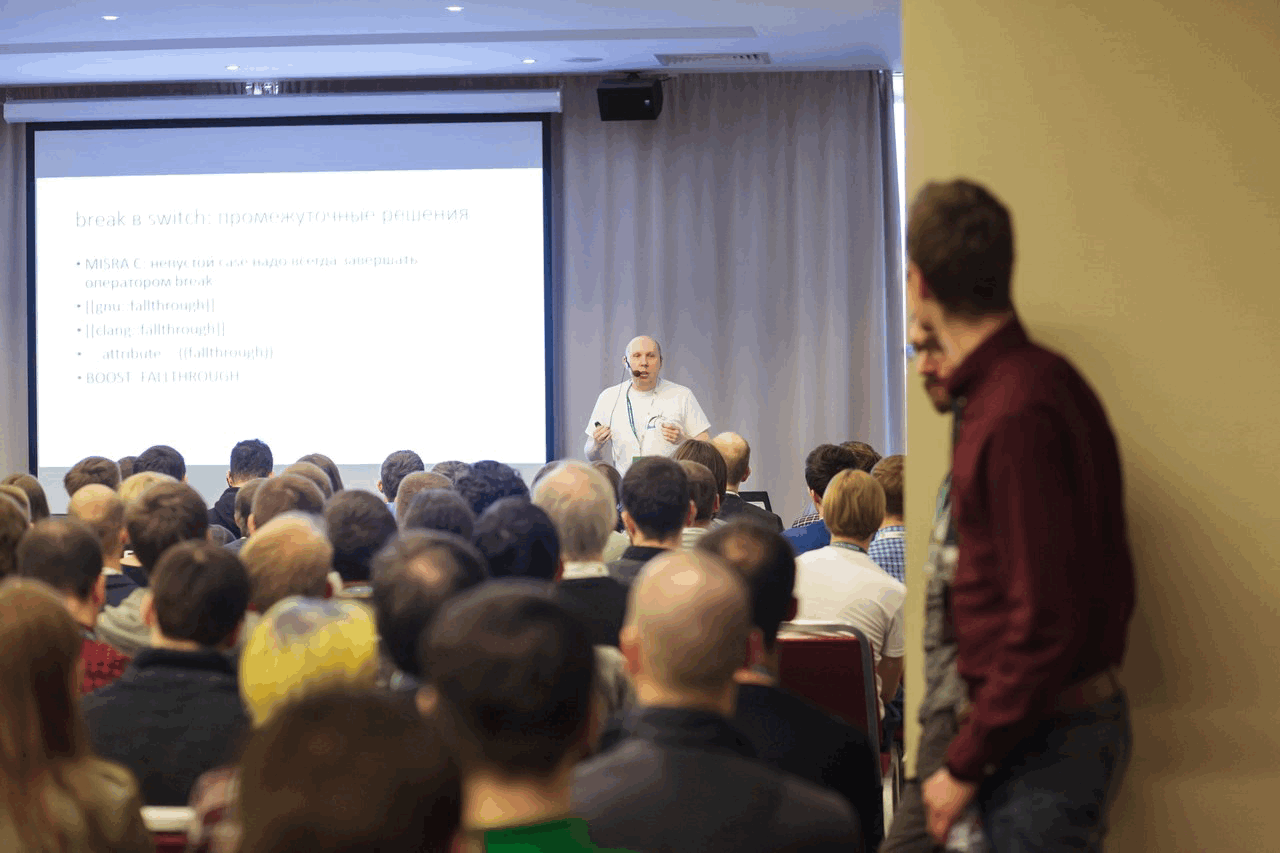
Positive Hack Days is an international computer security forum.
Our team was represented by Sergey Vasilyev, who was one of the experts at a roundtable session on static analysis and SAST (Static Application Security Testing). They brought up the issues of safe software development and the problem of convincing developers of static analysis' crucial role.
One thing that stuck to our memory was the show called "The Standoff", which took place in the main hall. It was a 30-hour cyberbattle between the teams of "attackers", "defenders", and "security operations centers" for control over a city.
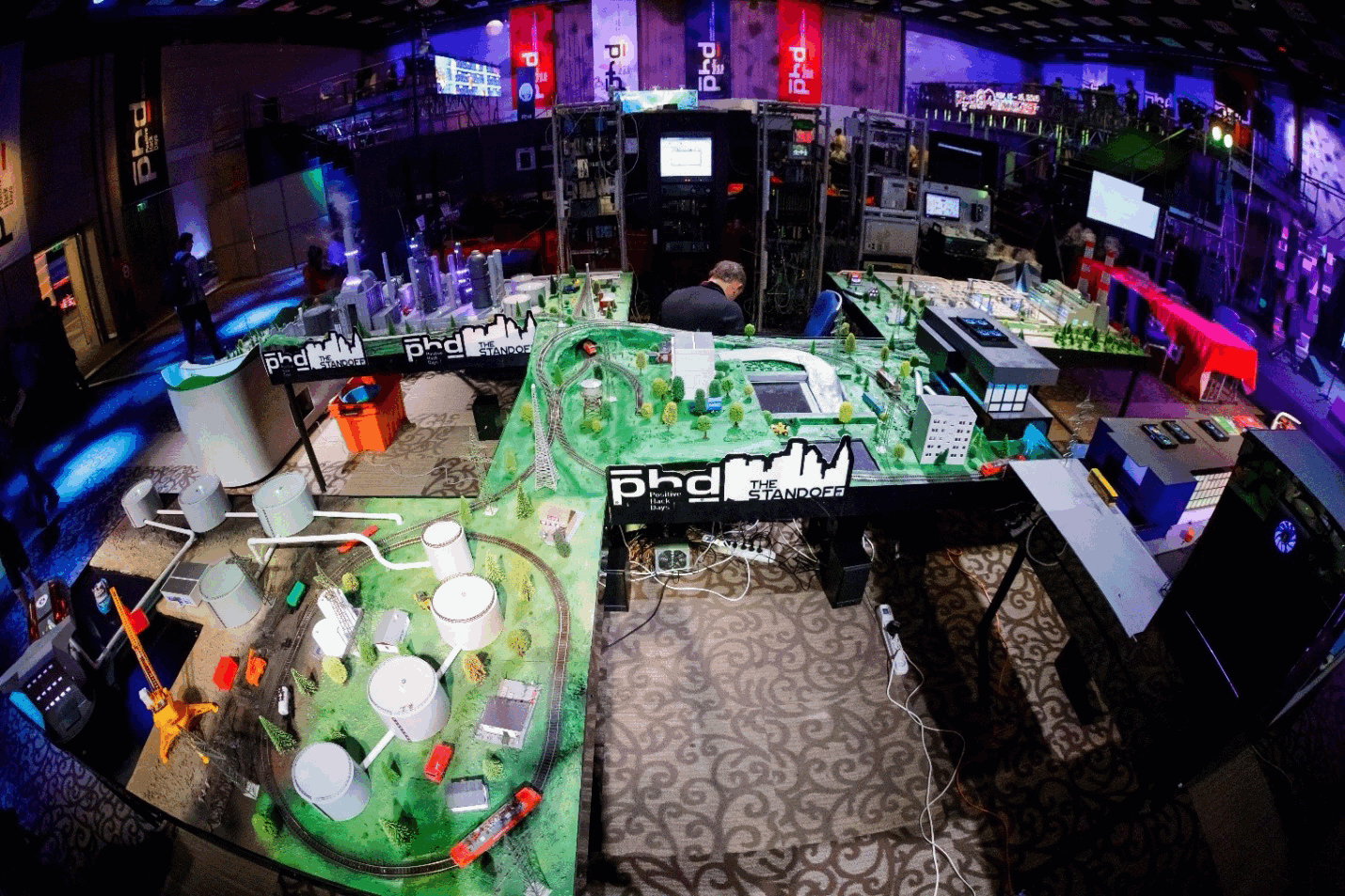
Playground scale model
For instance, the attackers were to hack the applications of the city's infrastructure to disrupt the railroad or power grid, while the defenders had to either prevent or fix the damage.
In the meantime, the guests were offered numerous presentations and workshops on computer security, with a computer-security exhibition, an art exhibition, bands' live shows, and games in the background.
DevConf is an annual professional conference dedicated to leading programming and web-development technologies.
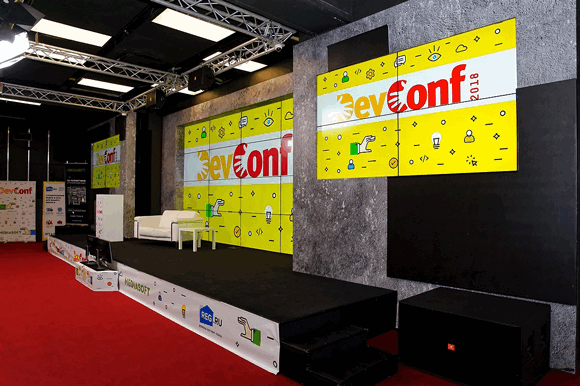
Even though most of the attendees were programmers, we didn't have much to talk about because they were mostly backend and mobile developers in PHP, Python, JS, Go, and other languages. Perhaps we should come again some other time, when we support these languages in our product.
Andrey gave the talk "Static Code Analysis", where he discussed the analysis methodology and tools. Keep an eye on the official YouTube channel for the video.
Conferences held by Oleg Bunin are among the best events held in Russia in terms of size, management, and variety of topics covered by speakers. We saw it for ourselves when participating in RIT++ for the first time. Unlike other managers, who only provide you with a space in the exhibition hall, leaving the rest to you, RIT++ management asks you to send them a booth model and brochure layout, which really helps a lot.
First, if you have a limited budget and cannot afford your own exhibition bundle, they'll provide you with a nice booth equipped with a counter and monitor. You only need to design it, and they will construct it for you.
Second, you don't have to bring your Pop-Up or Press-Wall because you will be provided with one that looks more expensive and attractive than yours.
Third, most of these booths are arranged in blocks; they look neat and nice and make perfectionists happy.
Fourth, brochures could also help you attract guests to your product or booth, depending on how creatively you design them.
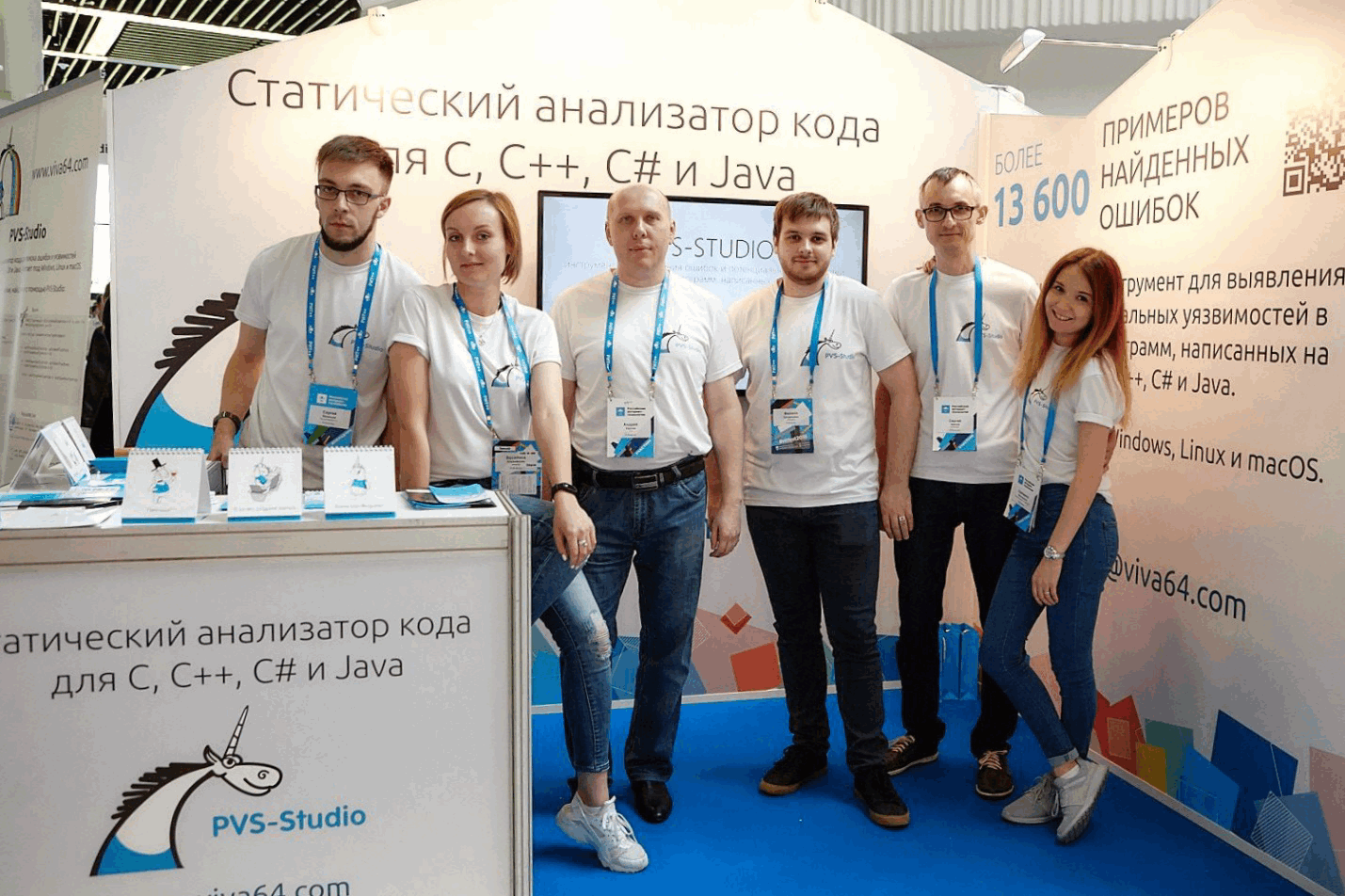
From left to right: Sergey, Vasilisa, Andrey, Filipp, Sergey, Ekaterina
RIT++ gathers people who deal with system administration and operation, highload systems and databases, server programming, project management and entrepreneurship, and frontend development. We made a number of contacts here and really enjoyed the conference. A detailed review is available in our VK group. The presentation [RU] by Sergey Vasilyev "Static Analysis as a Means to Improve Code Quality" is available there as well.
The DevOpsDays Moscow conference covered the topics of modern software development and maintenance methods and technologies.
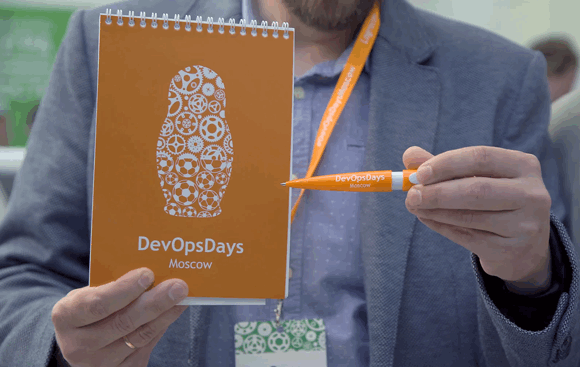
It's a cool event for sure, but the audience engagement aspect left us in mixed feelings. On the one hand, many of the attendees weren't quite our type and we didn't have much to talk about. On the other hand, we did meet people who heard about our product and came up to our booth to ask a few questions about the technicalities, and we did have a long and profound talk with some of them. It looks like we should come again next time if we don't get too tired and have enough resources left.
Our developers Filipp and Svyatoslav also held our first SonarQube workshop. We would then be bringing it to all the subsequent events, modifying it depending on the event format. You might wonder what our product, static analyzer PVS-Studio, has to do with SonarQube. Well, this is tricky. SonarQube is a platform for continuous code quality inspection that allows you to simultaneously visualize reports on a number of metrics. Such metrics can be represented by analysis results imported from bug and vulnerability detecting tools such as PVS-Studio and other static analyzers. This is how SonarQube can make things easier for companies that use several code quality verifying programs at once.
You can see the similar master class video further in the Yappi Days conference list.
White Nights Conference is an international business conference for game industry with the content across mobile, PC, console, web, AR and VR.
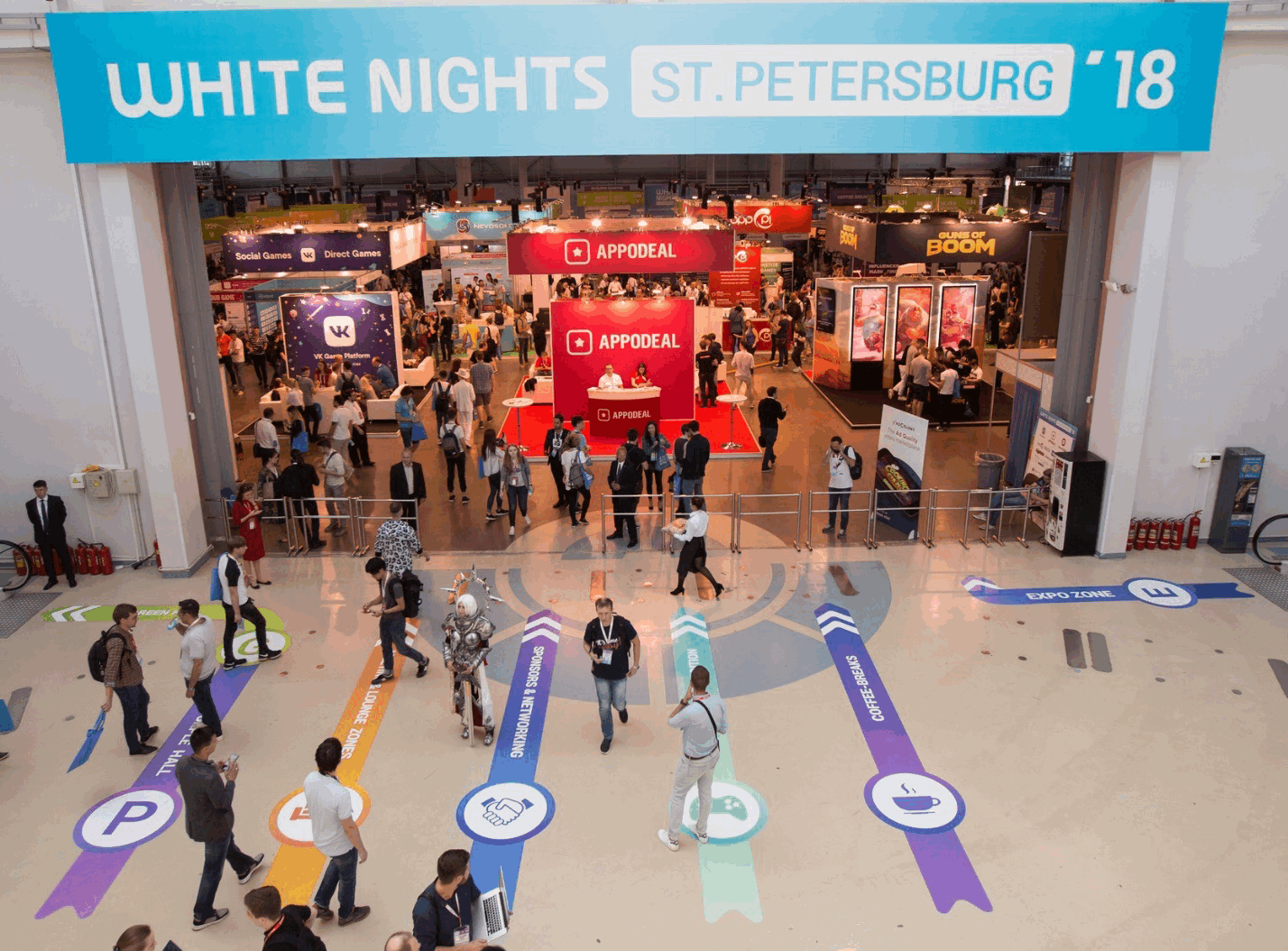
We only had a booth here, and it was at this event that we had a lot of excess items left. For some reason, people didn't show much interest in them. We didn't want to take them back home, so we just handed them out to other exhibitors at the end of the second day. The lack of interest could probably be explained by the diversity of the audience, which included not only programmers but also designers, marketers, producers, and people of many other occupations dealing with game development in general rather than coding in particular.
One thing that makes game industry conferences different from those aimed specifically at developers is the huge number of cool and creative booths. The hall throbs with light and sound, with game prototypes on screens, robots, cosplayers, and whatnot all over the place. Russian game industry leaders exhibiting side by side with indie startups. It must have been tons of fun to the guests, but as sponsors we didn't perfectly fit there.
This is a conference for IT business owners, founders, and top managers as well as anybody who is planning to develop a product or start their own IT business.
ISDEF saw a lot of presentations on how to start a business, participate in trade shows, present your product, bring it out to foreign markets, and so on. The event was held in a friendly atmosphere, with networking in the evening, which is as important as exhibiting or delivering talks.

On the downside, time limits allocated for speakers weren't always strictly met. As a result, many of the presentations were delayed and those who were to give a talk later had less time than speakers before them.
At the spring conference, our company was represented by Evgeny Ryzhkov, who gave the talk "10 Years on the Developer Tools Market: Looking Back at How We Changed Our Product, Marketing, and the Whole Business". In the fall, both creators of PVS-Studio, Evgeny Ryzhkov and Andrey Karpov, took part in the conference and shared some insights from their experience as exhibitors. Unfortunately, the managers don't allow uploading videos and presentations, so no links for this one, sorry.
This one is for those looking to improve their skill of managing small teams. It was the second conference by Ontico (Oleg Bunin) that we sponsored. We were already familiar with how it all worked and knew what to expect. It was at this event, however, that we learned how important it is to have different key words printed on your graphics when you target different audiences. After all, all the events that we had been to before were aimed at programmers for the most part.
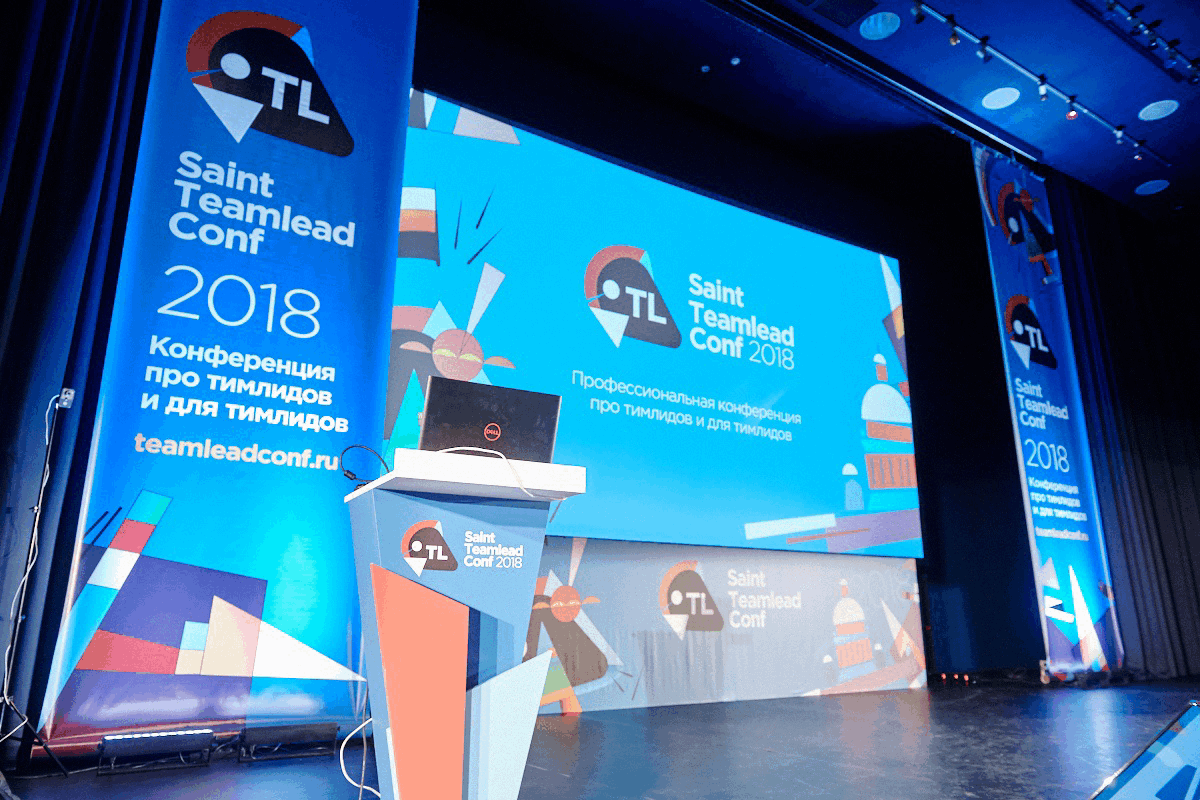
It was also at that point that we clearly defined the objectives of our sponsorship strategy. Namely, we would not only bring a booth, offer challenges, and promote our product but also collect the leads of anyone showing interest in PVS-Studio and send them a full Enterprise license for one month as a follow-up.
There were only two other sponsors at the event, so the visitors didn't spread out and we used this opportunity to engage them in a more productive discussion of various aspects of our tool. A beer party and board games followed in the evening, which helped everyone relax and make new contacts.
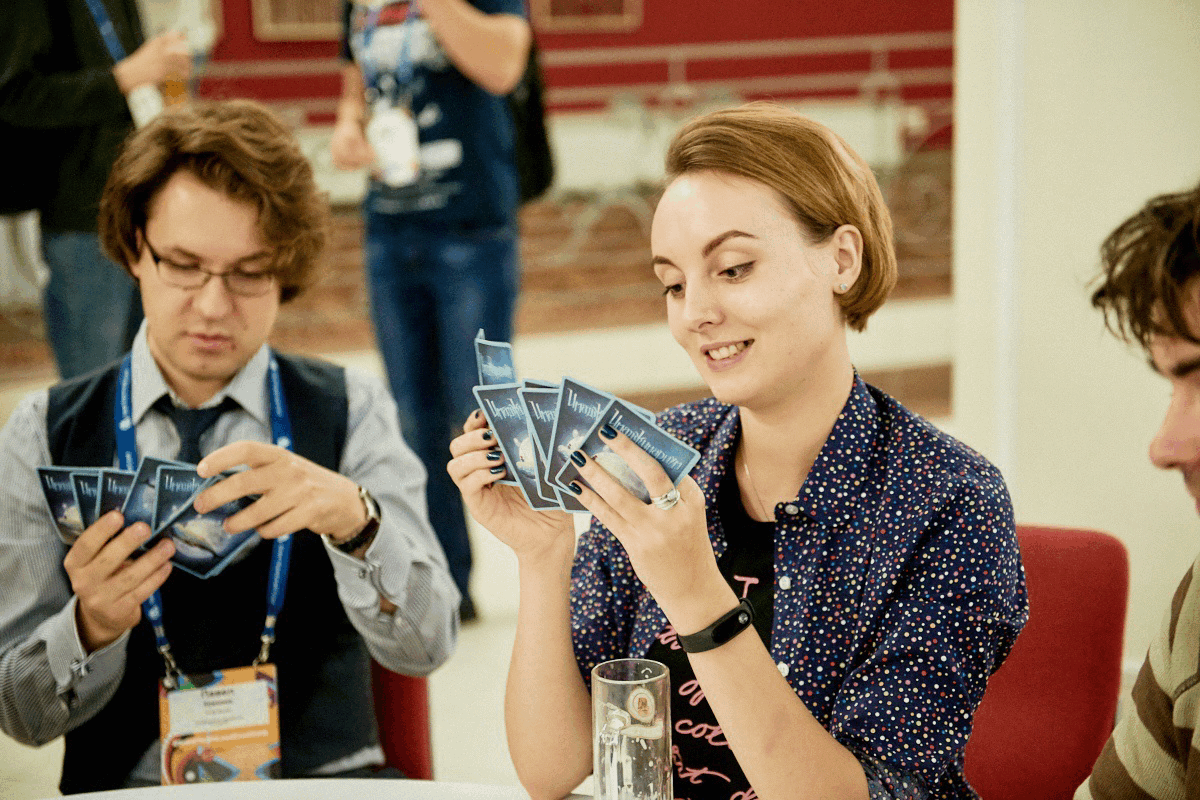
It's a global-scale conference gathering the best of the best of the C++ community. Over 1200 C++ developers come here from all over America and other countries. It is here that new features of C++ are presented first: standards, new versions of popular products, presentations by top speakers and authors.
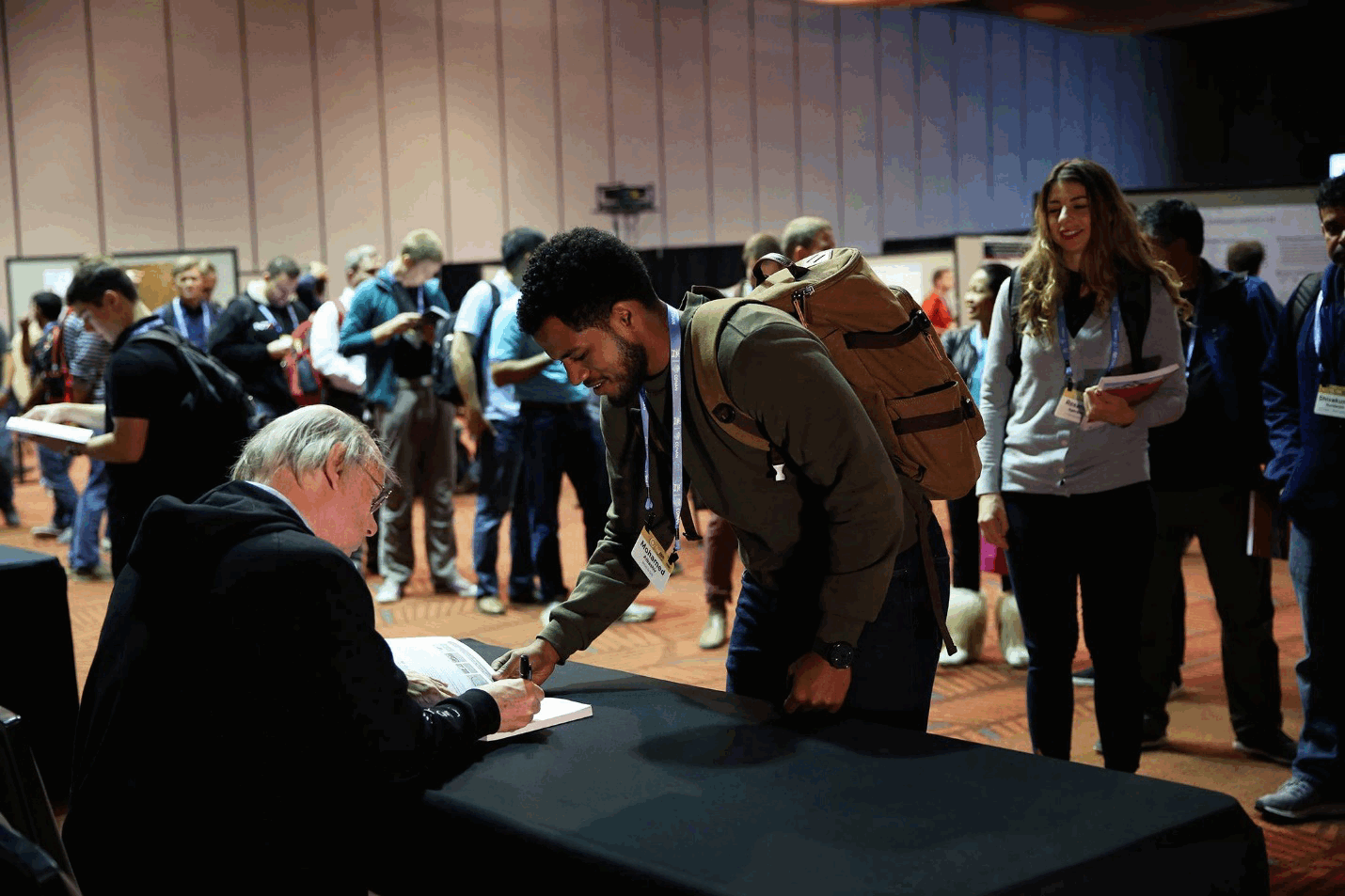
Bjarne Stroustrup at his book signing session. People lined up to get their copies signed by the author of the great and mighty C++.
Yes, this conference is on the list, but unfortunately, none of us made it there. We were faced with certain difficulties and unexpected obstacles, which you can't always tackle. Our team was still represented by a dear friend of us, Robin, who is an actively participating member of the C++ community. Robin didn't stay there for the whole week but only attended on September 26 and 27 to answer questions and tell the guests about PVS-Studio.
Hopefully, we will get to CppCon in 2019 with our PVS-Studio team to tell attendees about static analysis and our product.
It's a professional conference dedicated to integration of software development, testing, and operation processes. Again, it was organized by Ontico, and, again, we were there. By the way, it was the first time we attended a pre-party for sponsors before the conference.

No point repeating ourselves about how it's all well-done and exciting - here's just a link to Andrey Karpov's presentation "SAST, Fighting Potential Vulnerabilities".
A conference on big data, data science, and AI. The event itself was decent and gathered experienced speakers, but it wasn't quite our audience. This conference was one of the few events on this list where most of the attendees had never heard about us. We did have a few interesting conversations but not as many as we had hoped. It seems we don't quite belong here.
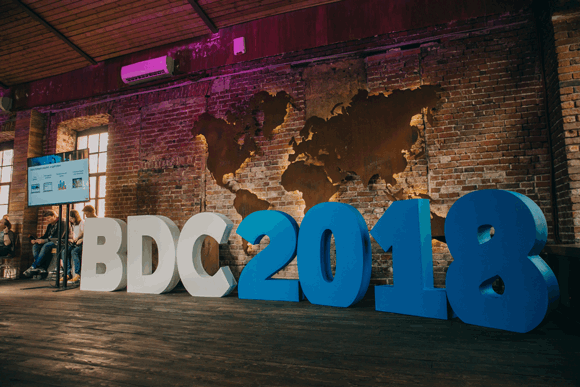
Luckily, we had anticipated that and made the right decision to bring only a couple of boxes with giveaways. And yep, our booth did look somewhat dull without a Pop-Up.
Software Engineering Conference Russia (SECR) is one of the most important and brightest IT events in Russia with a long history and recognized authority. It is aimed at programmers, testers and analysts, product and project managers, companies' key decision-makers, best students and scientists.
This conference was a debut for our C# developer Sergey Khrenov as a speaker. His presentation was called "Static Code Analysis: From Typos to Vulnerabilities". The audience enjoyed the talk and asked a bunch of interesting questions. In addition, we tested our workshop "The Practice of Using Static Analyzers", which ranked second at the conference. Svyatoslav and Filipp told the guests about various tools that help conveniently visualize analysis results and generate reports on multiple metrics.
The event was awesome. Besides attending the talks by other participants, we also gathered lots of prospects and held our first contest. Hopefully, we'll be coming again this year.
Joker is the main Java conference in Russia, which grows and becomes even more exciting every year. It brings together more than 1000 participants.
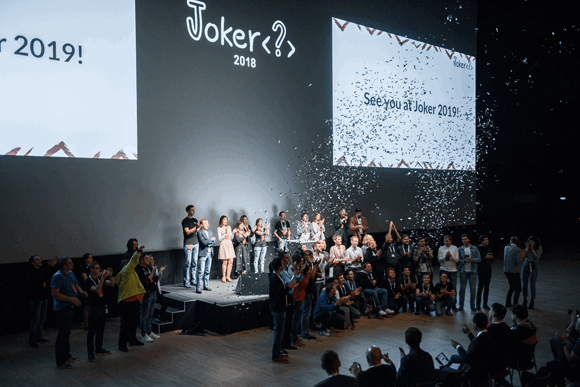
One of our Java developers attended the sessions and was very impressed by how it all was done, by the speakers and the session formats. Java puzzlers definitely stood out and were a hit. Puzzlers are code snippets that don't work the way that might seem at first. They are interactive (speakers show a code snippet and a number of possible execution outcomes for the audience to vote) and are a good way to attenuate the conference's hardcore tech style a bit.
We are going to participate in this conference with a booth and perhaps even a presentation this year. After all, PVS-Studio can now detect bugs in Java code too, so we do know something about that.
Yappi Days is a conference that brings up such topics as design patterns, corporate system architecture, distributed systems; cloud technologies, containers, orchestration, Continuous Delivery/Integration; popular front-end and back-end frameworks; software performance and monitoring.
It wasn't our first time in Yaroslavl. We participated as speakers in a conference called ADD2010 held there 8 years ago. I'm not sure if ADD2010 is the predecessor of Yappi Days, but it's good to see Yaroslavl host such events anyway.
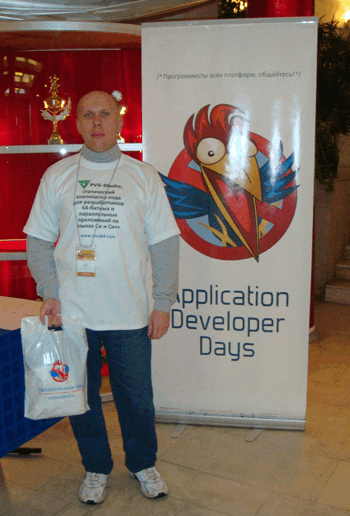
Andrey at ADD2010
The speakers covered a variety of topics - it was like RIT++ but on a smaller scale. There were much more sponsors and exhibitors than ever before, so guests had lots of booths to choose from. There were some minor problems with lunch organization, but hopefully, they will be fixed by the next time and the conference will become even better. In other respects, we enjoyed Yappi Days very much and will probably be participating again this year. In addition to the booth, we also prepared the presentation "Static Code Analyzer Development: Our Experience" and the workshop "SonarQube Guide: From Installation to Production-Code Analysis".
We were pleased to know that other exhibitors gave our booth a high score. Even though we ranked second, there's still much to be done.
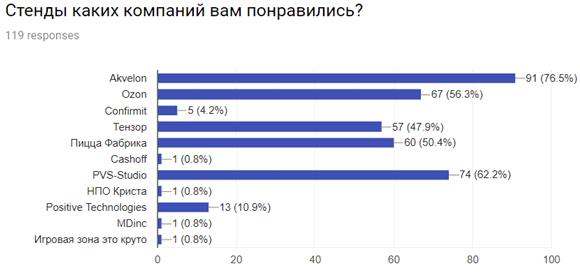
Since it was a one-day event, we decided to stay in Yaroslavl for a while to walk around the city and do some sightseeing. We admired the Volga, which flows through dozens of regions and is rightfully called the Mother of all Russia's rivers. Fall might not be the best season to fully embrace the Volga's beauty, but we could still feel its might while walking along the bank. Yaroslavl appeared fairly small: it took us only a few hours to see all places of interest in the center with its numerous ancient churches.
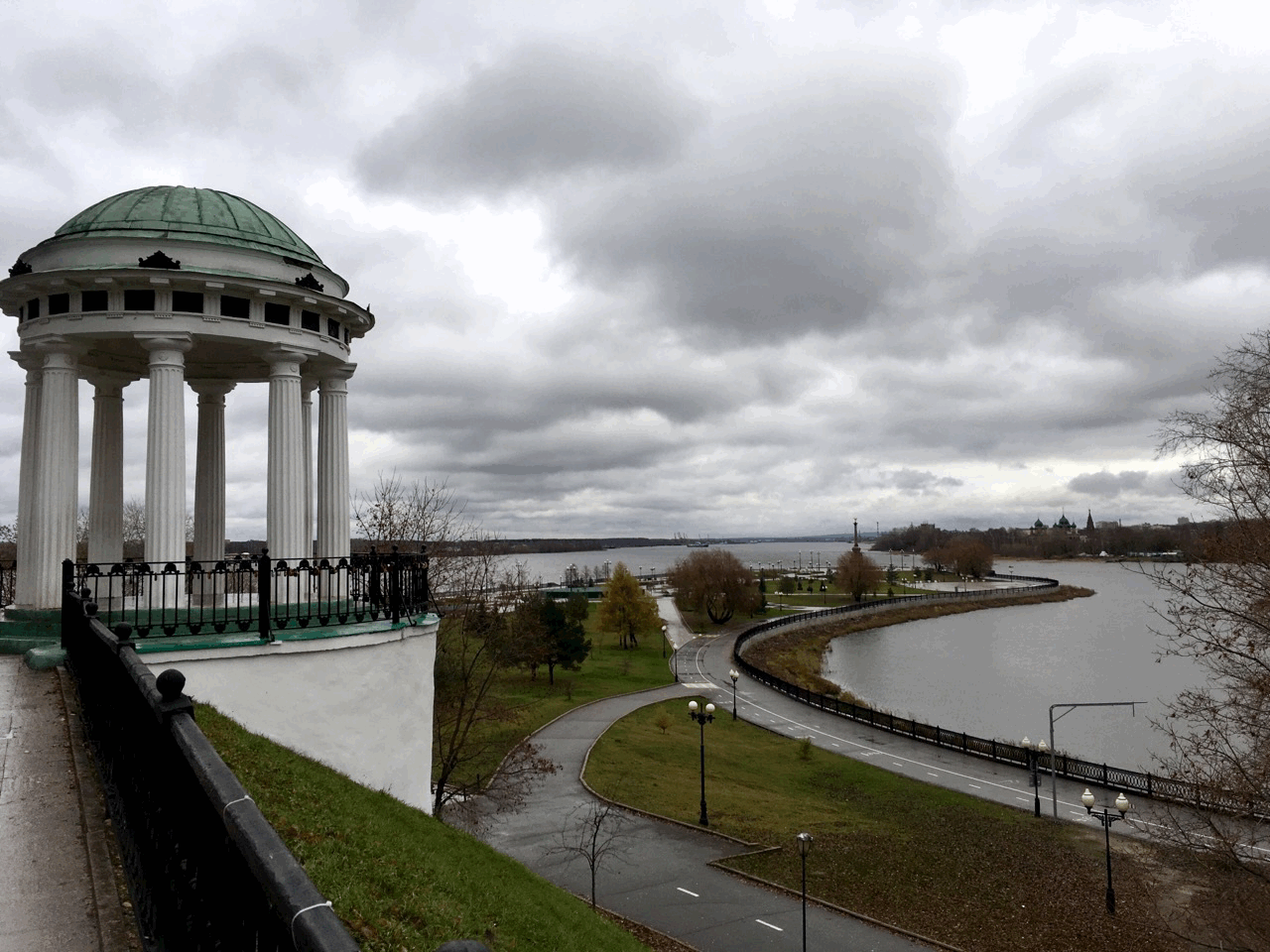
The last thing I'd like to tell you about before we move on is the wonderful restaurant Mili, which was a sweetest cherry on top in our Yaroslavl trip. You won't find many places like that even in Moscow, not to mention other regions. The interior, cuisine, service, prices, the serving and looks of the dishes - all surpassed our expectations. We were served in time, which was important since our train was to depart soon. Well, maybe we were just lucky to come in the early hour, when they have just opened and there weren't many guests yet, but we believe they do their job as perfectly even when all the tables are occupied. If you happen to be to Yaroslavl, do visit the place.
It's no advertisement - we really liked it a lot. Google it and you'll see tons of positive feedback
To finish with this section, here's the presentation and workshop videos:
Highload++ is the largest professional conference for highload system developers organized by Ontico. Out of all the events on this list, this one was the largest and classiest. Imagine 3000 attendees coming in a dense flow, never ceasing for a minute. And that was just what we needed. We tried to engage everyone (which wasn't easy) and add in some activities and contests so that our guests didn't get bored. A detailed review of that experience can be found in our VK group.
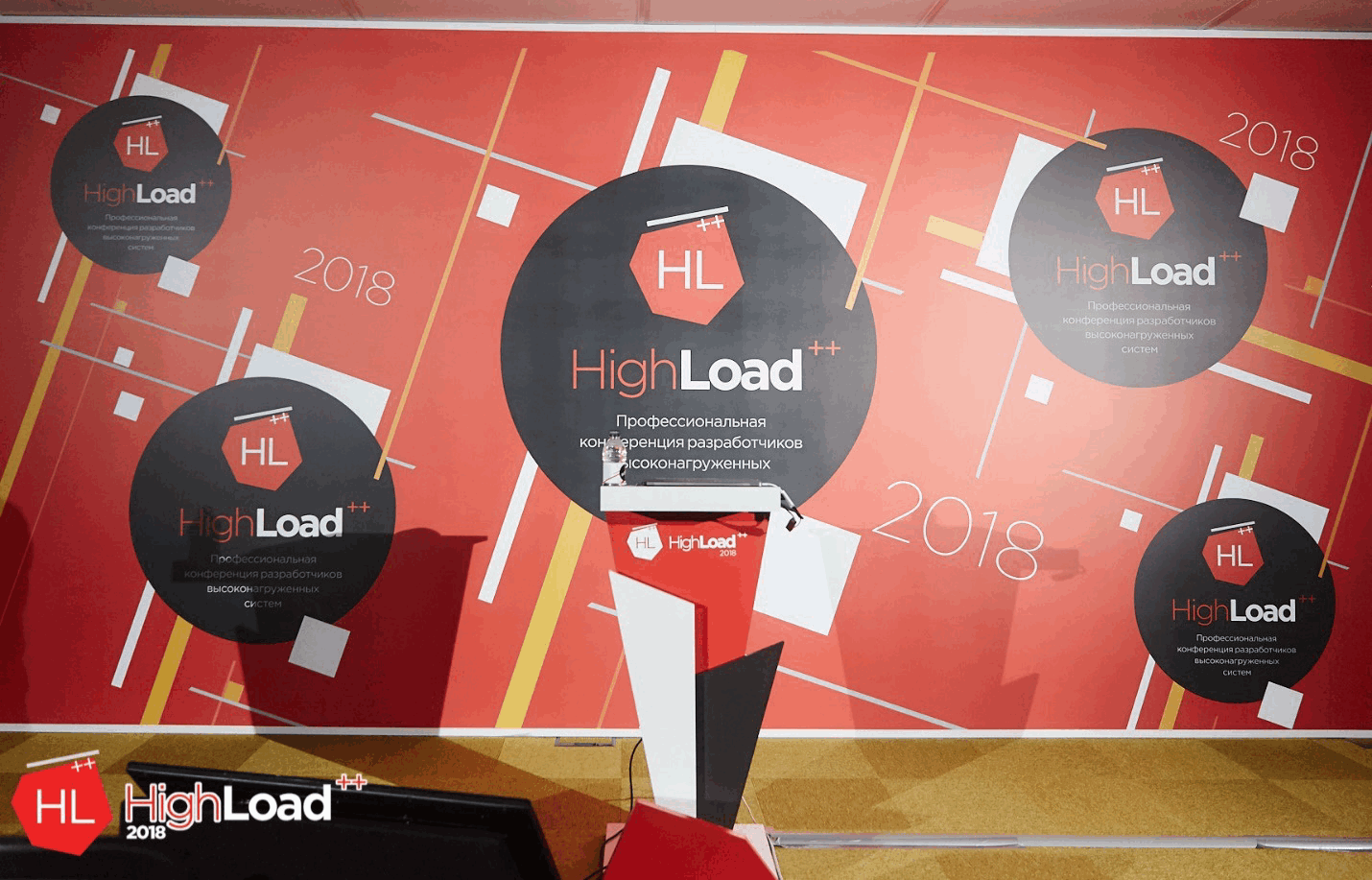
The videos won't be uploaded till April, so you've got to wait.
The largest regional conference for IT businesses and specialists held by the local vendors. Because Tomsk is pretty far from Moscow or Saint Petersburg (it takes four hours to get there by plane, which is the same time it'd take you to get to Egypt, but the temperature in Tomsk is -20 °C VS Egypt's +30 °C), the attendees were looking to some fun and non-trivial activities, and the organizers did their best to meet their expectations. Gorod IT covers a variety of topics and is aimed at a broad audience, which was a problem for us. But the event itself is very exciting, that's for sure.
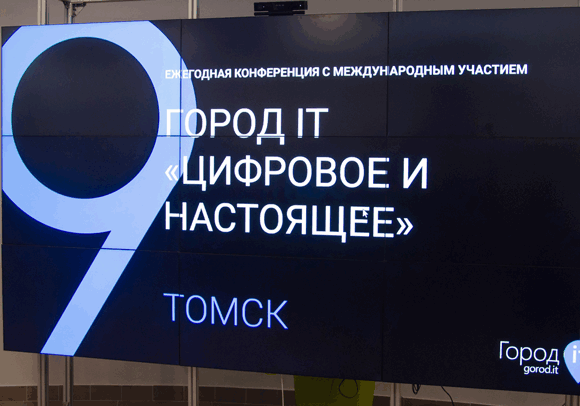
This time they had a C++ track organized by the company TomskSoft. Its CTO, Anton Tushmintsev, invited Evgeny Ryzhkov to give the talk "C++ Bug Patterns in Cross-Platform Development". Of course, Anton knew that PVS-Studio had started as a product called Viva64, which was specifically designed to detect bugs occurring when porting programs to 64-bit systems. Besides, PVS-Studio now supports Windows, Linux, and macOS, so we do know something about cross-platform development.
Evgeny shares his impression of Tomsk:
"It was my first visit to Tomsk. It was +5 °C in Moscow when I left, and in Tomsk I was met with a -20 °C frost. Quite refreshing, you know! When I was boarding the plane back to Moscow at 5 a.m., the temperature on the field was -25 °C. But no matter what, I liked Tomsk. Anton took me on an exciting excursion to TomskSoft's office and introduced me to their CEO Ilya Bezkhodarnov, with whom we discussed the issues of migration... of programmers, not programs. From Tomsk to Saint Petersburg. Looks like it's not only me who can't stand cold weather."
OK, let's get back to the conference. It encompassed sessions on business, marketing, development, and legal aspects of software development. We liked it as guests, but it doesn't look that promising for us as sponsors because the event is too spread out thematically.
Meeting C++ is an independent platform for C++, supporting the C++ community by sharing news, blogs and events for C++.
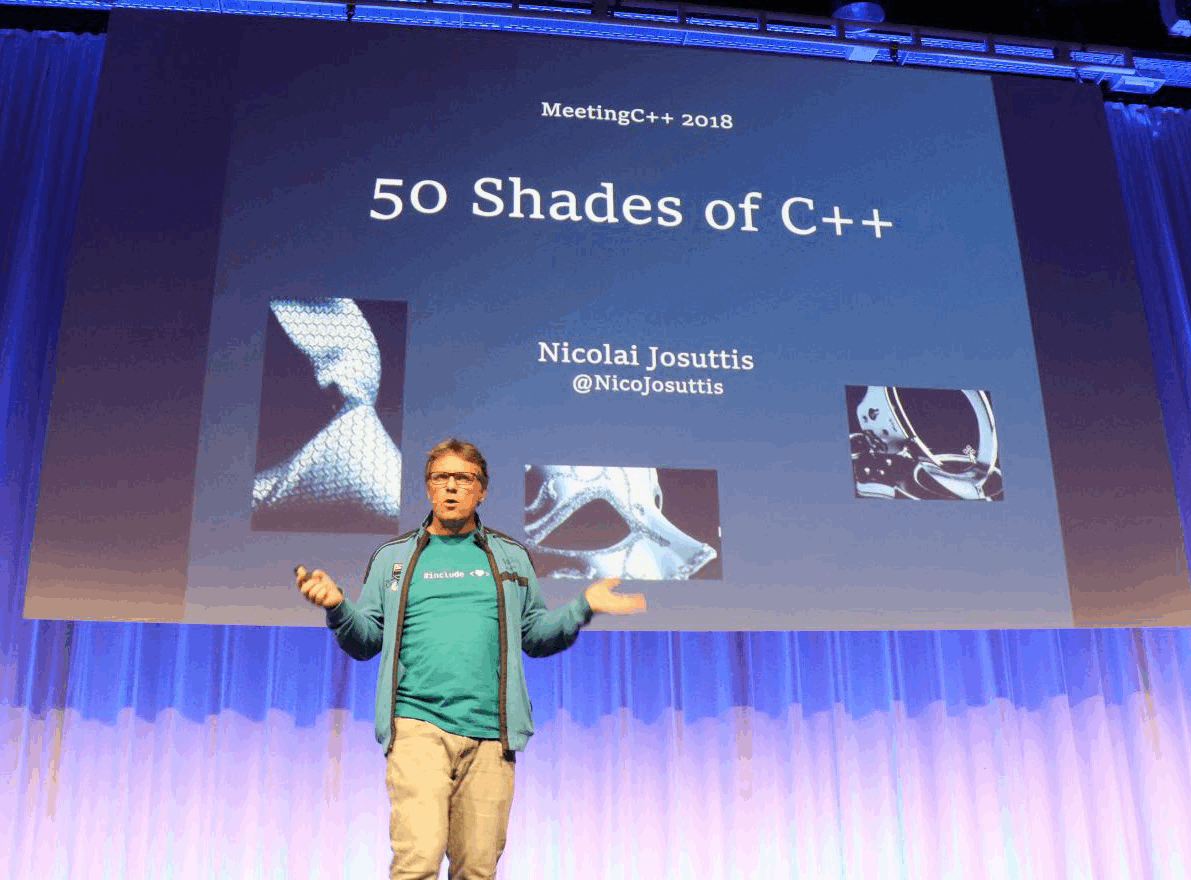
Like C++ Russia, Meeting C++ is very ad-hoc and relevant to what we do. We didn't manage to get there as sponsors, but Egor Bredikhin did give the talk "How to Write More Reliable Code?", where he showed a bunch of defects found in C++ code, many of which could have been avoided by using code quality control tools and modern techniques such as unit testing, style guides, new C++ standards, code review, static analysis, dynamic analysis, and many others.
In Germany, and Europe in general, commuting by bike is very popular. So it felt just right that exhibitors played with the cycle sport theme in their giveaways' design. The guests could choose from a large variety of branded fitness trackers, cycle sport related gadgets, bike bottles, and LEDs.
One major difference from Russian conferences was that water was provided only in glass bottles: it's part of Europe's plastic banning and environment protection policy. The bad thing, though, is that a half-empty bottle can't be sealed back, which makes it inconvenient to carry around, so the whole place was littered with unfinished bottles.
We attended a bunch of interesting presentations by the leading C++ developers: Andrei Alexandrescu, Lisa Lippincott, Nicolai Jossuttis, and others. There was also one presentation by Russian developer Anton Polukhin from Yandex.
Unfortunately, the guys didn't have much time to see the city and had to leave for home on the last day.
DevGAMM is the largest conference for game industry specialists in Russia, Ukraine, and Belarus. It does have its strong points such as high-quality content on game development, low entry threshold for beginner developers, and a series of activities implying productive meetups and networking.
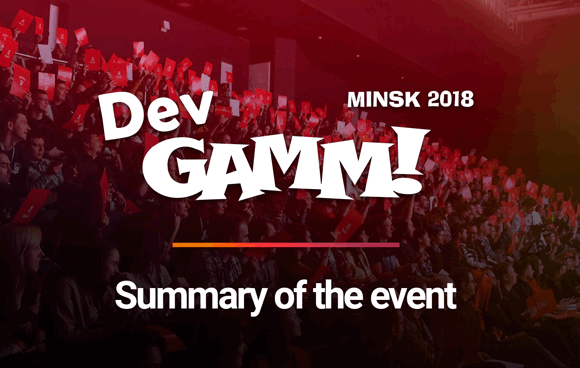
As you would expect of any game conference, the venue was beautifully decorated and there were tons of activities everywhere. At one end of the hall, you've got girls cosplaying videogame heroes for anyone to take a photo with; at the other, you've got multiple activities such as VR, desktop, mobile, and other applications. Add quests with cool prizes, roundtables, interesting presentations, networking, various entertainment activities at the end of the first day, and the $30,000 Best Indie Game reward.
Our team was represented only by Andrey, who gave the talk "64-bit Bug Patterns in Video Games", where he showed how one could get into trouble when using C++ without due care.
Unfortunately, just like at White Nights Conference, the audience was too broad. At least that's what it looked like to Andrey. There were too few programmers, let alone C++ programmers, and, therefore, few attendees at the presentation. If we still want to participate in this event again, we'll have to talk on some more general topics.
It's the only exhibition on information security on this list. It ran for three days and was expected to gather 5000 guests, but it looked like the actual number was about three times smaller. Most of the attendees were students from Information Security faculties who were brought along by their teachers. As for the teachers, we engaged some of them in an interesting conversation about integration of PVS-Studio into the curriculum so that programmers-to-be became familiar with the static analysis methodology and ways to apply it from the very beginning.
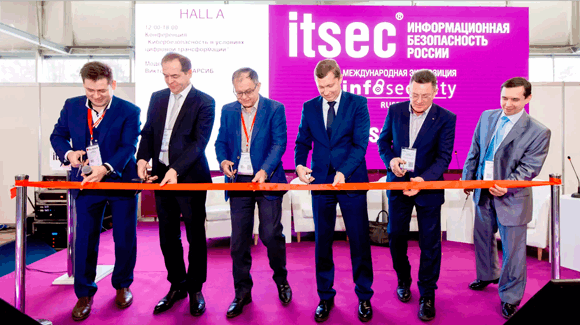
There were also many elderly people teaching at universities or working for governmental organizations. It was funny to hear some of them ask if they could get a CD with a copy of our program, or wonder how we hadn't gone bankrupt yet without support of the upcoming GOST or offering only static analysis instead of dynamic analysis or ignoring PHP and Python...
Here's another thing that we will remember for long. Since it was an expo rather than a conference, it didn't include free meals, though you could buy some snacks such as light salads, sausage buns, or patties. We didn't worry about that because we had food delivered from a café. But the expo wouldn't close until 19 p.m., and at some point, some of us felt very hungry. So, one of our team members went to buy a sausage bun. Now, imagine how shocked we were to see her come back carrying a sausage bun wrapped in a piece of cardboard that had once been a nylon pantyhose package. Pantyhose sausage - because we're worth it. :) That was epic! The salesperson must have run out of wrapping paper and had to substitute it with whatever they had at hand.
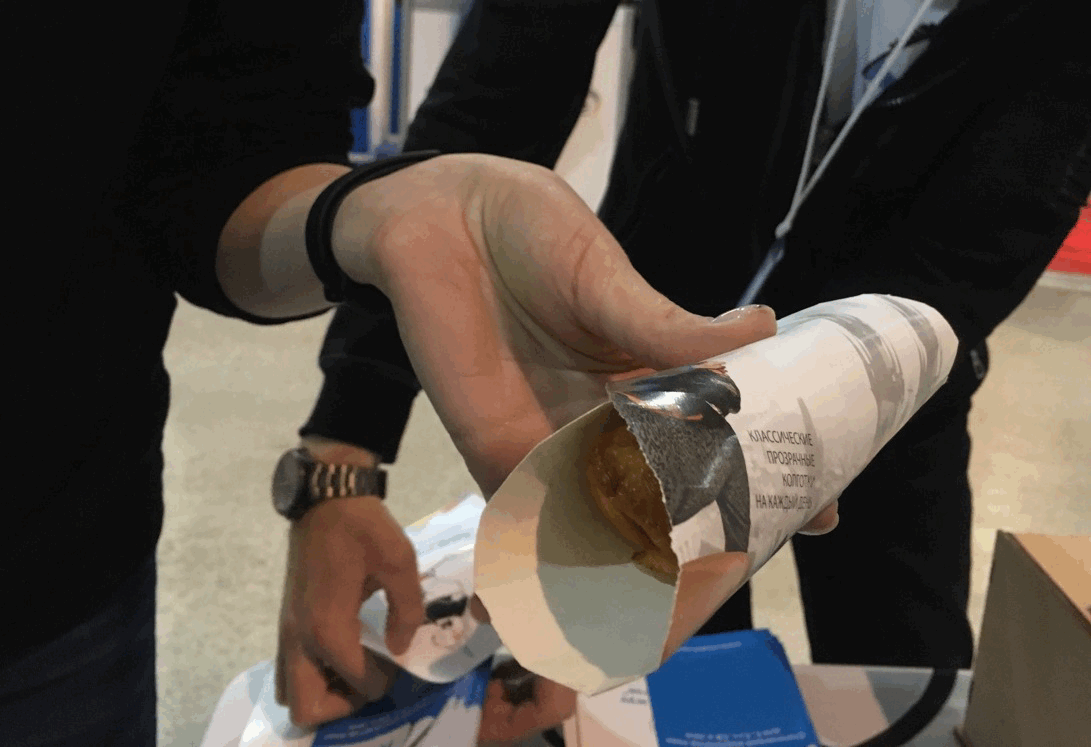
Overall, the ITSec exhibition was somewhat slack. Unlike conferences, it wasn't exciting, and the audience wasn't quite ours - too few developers and testers and, therefore, too little productive communication. Time was dragging on, and by the end of the day we all were exhausted.
This conference overlapped with the ITSec exhibition, so half of our booth staffers drifted from one venue to the other. We were a bit late at SQA Days, and while we were unpacking our gear, we noticed that half of the guests were girls. Not that I'm pointing out some gender aspect now - it's just that women, more than men, tend to spot cute things. As soon as we laid out our desktop statuses and other items, the girls would flock to our booth smiling and chirping, "Oh, these unicorns are so cute!", and snatch them up.
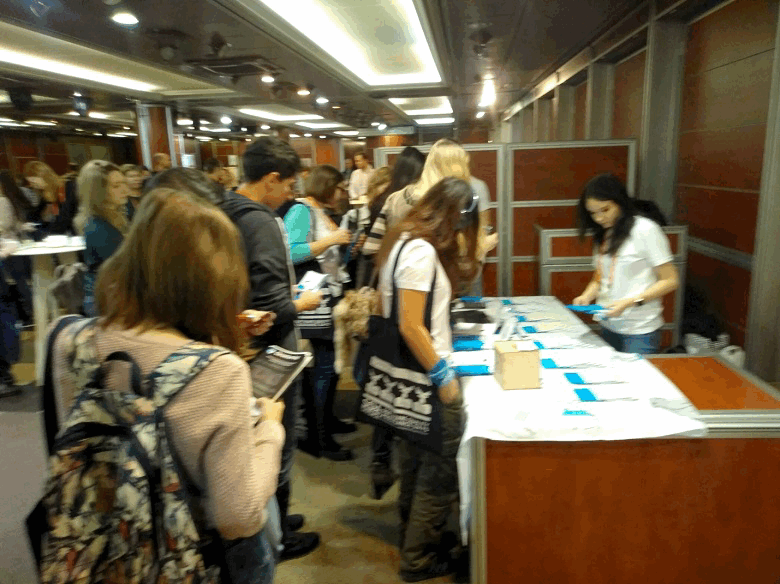
A bit blurry, but you get the point
The conclusion is, try to arrive in time because if there aren't many booths and there's still some time left before the sessions begin, other exhibitors will gather at your place and snap up your giveaways in seconds, leaving you no chances to properly engage prospects.
SQA Days made a good impression on us, and even though testers aren't our target audience, we believe they should know more about static analysis and PVS-Studio, too. After Evgeny Ryzhkov and developer Maxim Stefanov presented their talks, some of the guests came up to our booth and we promised to send them a free PVS-Studio license key. Which means all that trouble was not for nothing.
Heisenbug is a large technical conference that brings together more than 500 professionals in the field of quality assurance: testers, programmers developing tests for their code, engineers in automated and load testing, and team leads willing to improve testing efficiency in their projects. This conference (among many others) is held by JUG.ru Group, a team that organizes conferences and meetups for developers from various fields. Here, Andrey gave the talk "Things that Static Analyzers Can Do and Programmers and Testers Cannot".
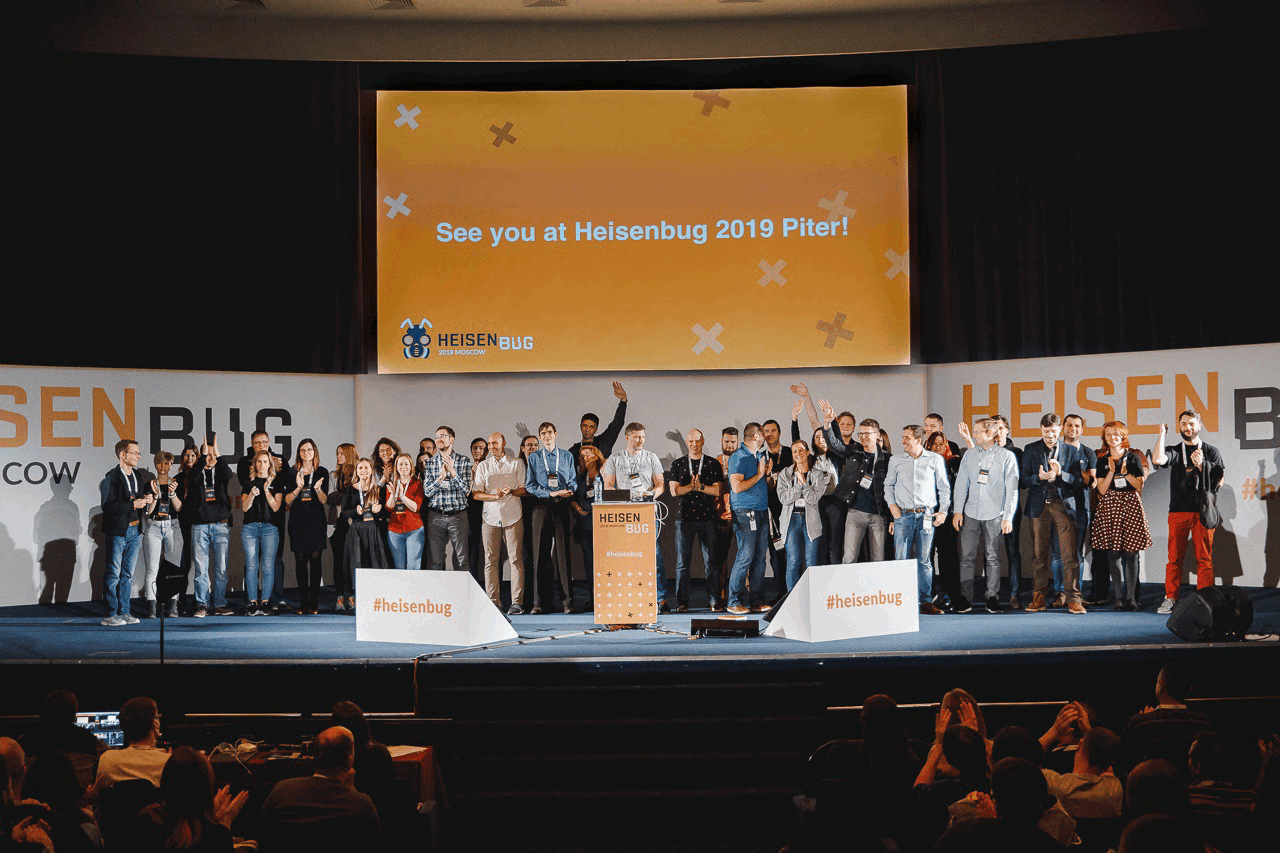
Andrey said the atmosphere, the organizational aspect, and the presentations were all first-rate. Which means we should participate in some other conferences held by JUG.ru in 2019, not only as speakers but also as exhibitors.
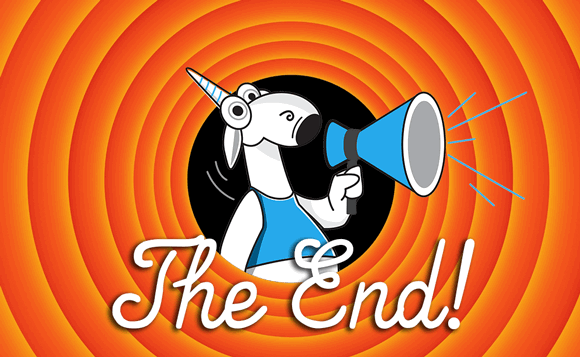
Phew, that's all, I guess. The last thing I'd like to say is that 2018 was a very intense year for us, and we definitely became more mature and experienced as speakers and exhibitors. Not everything was smooth, of course, but we learn from our mistakes, draw conclusions from our past experience, and heed advice. And we perform better at each new event - at least that's how we see it :)
Will your company benefit from conference sponsorship? Sure! But it may be difficult to express that benefit in precise figures. We outlined the following reasons why it's good for us:
So, we must carry on and carefully choose which conferences to participate in this year to carry out our mission of enlightening the world on static analysis even better. By the way, Andrey has already prepared a new event calendar for 2019.
0